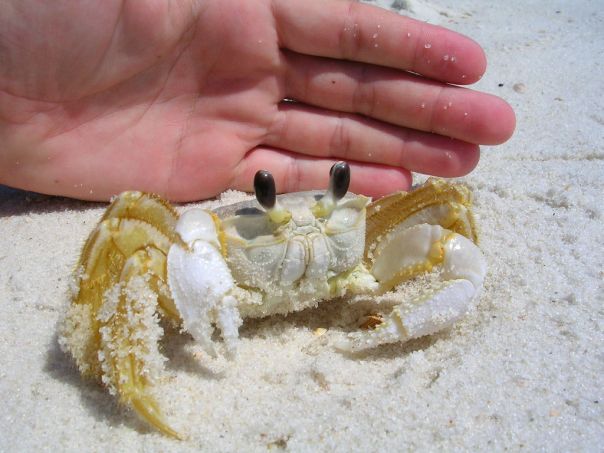Outer Banks, North Carolina
In this week’s episode of “Who’s in That There Hole?” we travel to a beach on Outer Banks of North Carolina….
While walking on the beach and not paying attention to my three-year-old to make sure he didn’t swim off to Spain, I spotted a quarter-sized hole. The beach had several quarter- to baby-fist-sized holes in the sand, but no obvious occupants. I started digging in the sand, using my hand as a steam shovel. Each scoop of the cool sand got me closer to the treasure I was hunting for. When I was elbow deep in the sand, I found the treasure. Then it pinched me and skimmed across the sand like shuffleboard puck. I chased it into the water and slapped my hand down on it. It was a ghost crab, Ocypode quadrata.

The name Ocypode means ‘fast-footed’ (Ocy=fast, pod=foot, as in podiatrist). And they are fast as a lizard on a hot skillet. These cryptic crabs are found from at least Rhode Island to Brazil and are most active at night. Once, while camping in Perdido Key, Florida, a friend felt something thumping him from underneath his sleeping bag. He lifted up his bag and a large ghost crab angrily shook his claw and ran off into the night. The ghostly carapaces of these crabs perfectly camouflaged them against the sand so that when they run it looks like a patch of the beach grew legs and ran away.

Ghost crabs live in single burrows above the high-tide line that are 1.5-3 foot deep (so elbow to shoulder deep for me). They are semi-terrestrial, meaning they live on relatively dry land but need to run to the water to wet their gills occasionally. A ghost crab will drown if constantly underwater. So if you find yourself on a beach between Rhode Island and Brazil and see quarter- to baby-fist-sized holes above the high-tide line, it might just be a fast-footed ghost crab.*

*There are other animals that burrow on the beach including rats and fiddler crabs (e.g., Uca pugilator, the sand fiddler). Fiddler crab burrows often occur in colonies with many quarter-sized holes clustered together, not in single burrows far apart from each other like ghost crabs. And fiddlers, unlike the shy ghost crabs, are showboats, the males constantly waving their oversized claws.